On 26 December 2013, Hungarian-born singer and actress Márta Eggerth (1912-2013), who maintained a global career for over 70 years, died in Rye, New York. She was the popular and talented star of 30 German and Austrian operetta films of the 1930s. Many of the 20th century's most famous operetta composers, including Franz Lehár, Fritz Kreisler, Robert Stolz, Oscar Straus, and Paul Abraham, composed works especially for her. After the rise of the Nazis, she continued her career with her partner Jan Kiepura in the US. Ms. Eggerth was 101.

German postcard by Ross Verlag, no. 6799/1, 1931-1932. Photo: Freiherr v. Gudenberg.

German postcard by Ross Verlag, no. 7096/2, 1932-1933. Photo: Atelier Kiesel, Berlin / Aafa Film.

German postcard by Ross Verlag, no. 7311/1, 1932-1933. Photo: Atelier Binder, Berlin.

German postcard by Ross Verlag, no. 7875/1, 1932-1933. Photo: Atelier Binder, Berlin.

German postcard by Ross Verlag, no. 8356/2, 1933-1934. Photo: Atelier Binder, Berlin.
Márta (or Martha) Eggerth was born in Budapest in 1912. Her mother, a dramatic coloratura soprano, dedicated herself to her daughter, who was called a 'Wunderkind'.
At the age of 11, she made her theatrical debut in the operetta 'Mannequins'. Marta began singing the demanding coloratura repertoire by composers including Rossini, Meyerbeer, Offenbach, and Johann Strauss II.
Soon she was hailed as Hungary's 'national idol'. She performed at the Hungarian State Opera in Budapest. Eggerth made her film debut in Budapest in such silent films as Csak egy kislány van a világon/There Is Only One Girl in the World (Belá Gaál, 1929).
While still a teenager, Márta Eggerth embarked on a tour of Denmark, Holland and Sweden before arriving in Vienna at the invitation of Emmerich Kalman. Kalman had invited her to understudy Adele Kern, the famous coloratura of the Vienna State Opera, in his operetta 'Das Veilchen von Montmartre' (The Violet of Montmartre). Eventually, she took over the title role to great critical acclaim after Kern suddenly became indisposed.
Next, she performed the role of Adele in Max Reinhardt's famous 1929 Hamburg production of 'Die Fledermaus' (The Bat). At the age of 17, she was perhaps the youngest singer ever to undertake this part. Her silvery soprano voice made her a popular star of the operetta in the following years.

Dutch postcard by JosPe, no. 330. Photo: City Film.
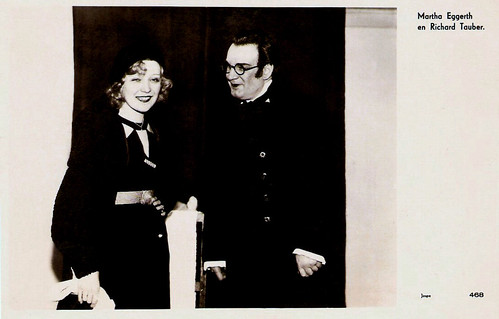
Dutch postcard by JosPe, no. 468. With Richard Tauber.
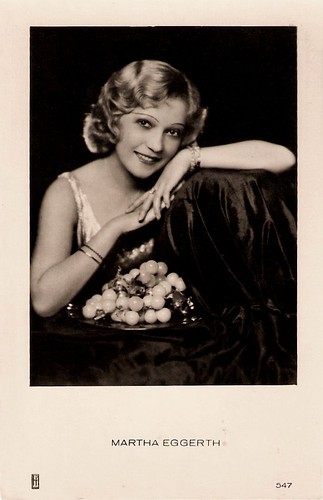
Dutch postcard by JosPe, no. 547.

Dutch postcard by JosPe, no. 593.

Dutch postcard by Filma, no. 664.
Márta Eggerth's film career really career took off with the German sound film Bräutigamswitwe (Richard Eichberg, 1931) co-starring Georg Alexander. It was based upon the play, Unwelcome Wife, written by Edward A. Paulton and Fred Thompson. It tells the story of two philanderers who marry each other.
Bräutigamswitwe is the German-language version of the British film Let's Love and Laugh (Richard Eichberg, 1931) which was made simultaneously but with Muriel Angelus. The success of the film resulted in international fame for Eggerth.
Her next film was a crime film, Der Draufgänger/The Daredevil (Richard Eichberg, 1931) also starring Hans Albers and Gerda Maurus. Der Draufgänger was the second film by Richard Eichberg after Der Greifer/The Copper (Richard Eichberg, 1930), in which Hans Albers played an energetic policeman and thus cemented his image as Blond Hans and early action hero of German sound film. The film was shot at original locations in Hamburg harbour.
Then followed the film operetta Trara um Liebe/Trumpet Call of Love (Richard Eichberg, 1931) with Maria Paudler and Georg Alexander, the drama Eine Nacht im Grandhotel/Night at the Grand Hotel (Max Neufeld, 1931) and the comedy Moderne Mitgift/Modern Dowry (E.W. Emo, 1932) with Georg Alexander and Leo Slezak.
Franz Léhar composed the music for Es war einmal ein Walzer/Once There Was a Waltz (Victor Janson, 1932), especially for Eggerth. The story was written by the young Billy Wilder. The film was remade in Britain as Where Is This Lady? (Victor Hanbury, Ladislao Vajda, 1932), again with Márta Eggerth in the leading role.
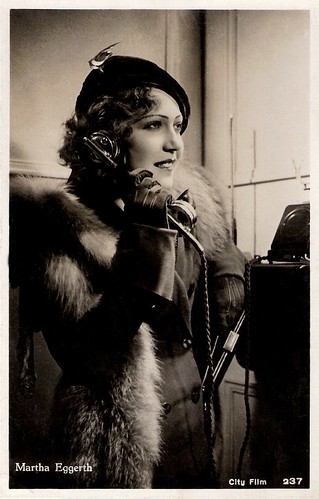
Dutch postcard, no. 237. Photo: City Film.

Dutch postcard by City Film, no. 464. Marta Eggerth and Hans Junkermann in Traum von Schönbrunn/Dream of Schönbrunn (Johannes Meyer, 1932). Sent by mail in 1934.

Dutch postcard by Filma, no. 450. Photo: publicity still for Die Blume von Hawaï/The Flower of Hawaii (Richard Oswald, 1933), an adaptation of the operetta 'The Flower of Hawaii' by Paul Abraham.
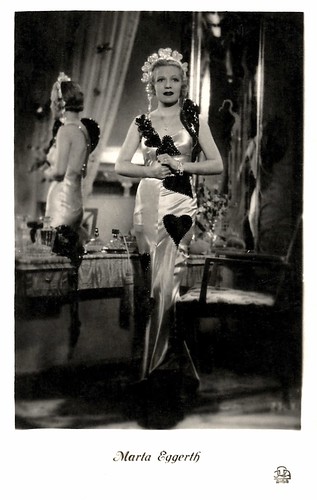
Latvian postcard by IRA, Riga.
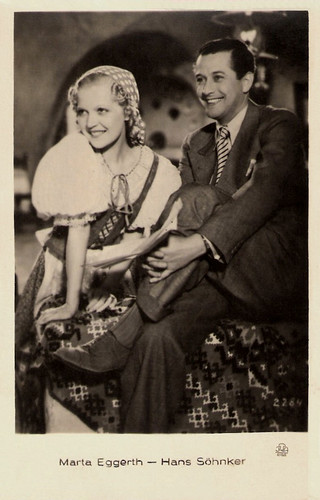
Latvian postcard, no. 2284. Photo: J. Rolin (?), Riga. With Hans Söhnker.

Latvian postcard by IRA, Riga, no. 2734. Photo: Ars.
In the silver age of the operetta Márta Eggerth starred in numerous successful film operettas and musical comedies as the cheeky, captivating girl like in Das Blaue vom Himmel/The Blue from the Sky (Victor Janson, 1932), but she also played more tragic roles.
The Austrian-German musical Leise flehen meine Lieder/Gently My Songs Entreat (Willi Forst, 1933) with Hans Jaray is a biopic of the composer Franz Schubert (1797–1828). It was Willi Forst's directorial debut. The German title refers to the first line of the Lied 'Ständchen' (Serenade) from Schubert's collection Schwanengesang, which Eggerth performs in the film.
A British version was also made called Unfinished Symphony (Anthony Asquith, Willi Forst, 1934), again with Jaray and Eggerth. This title refers to the story that Franz Schubert left his symphony unfinished after losing the love of his life. The New York Times wrote: "Hans Jaray's performance reveals Schubert as a gentle and sad-faced youth, inordinately sensitive and at the same time filled with modest confidence in his genius. The well-known German actress and singer, Marta Eggerth, is the lovely aristocrat who laughed at the wrong time, and she helps the photoplay considerably with the warmth and skill of her interpretations of the Schubert songs."
To Eggerth's great successes belong also such film operettas as Der Zarewitsch (Victor Janson, 1933) and Die Czardasfürstin/The Csardas Princess (Georg Jacoby, 1934) and the comedy Die ganze Welt dreht sich um Liebe/The World's in Love (Viktor Tourjansky, 1935).
Critics praised her musical abilities, but also her nuanced acting. In favour of her film work, she appeared less and less on stage.

Dutch postcard.

Dutch postcard.

French postcard by Editions P-C, Paris, no. 113. Photo: Super Film / Vanderheyden. Marta Eggerth sang the English Waltz 'Je veux t'aimer' in C'est un amour qui passe , the French language version of Ein Lied, ein Kuß, ein Mädel/A Song, a Kiss, a Girl (Géza von Bolváry, 1932).Text by Jean Sorbier and music by Robert Stolz. Copyright: Alrobi, Berlin / Editions Salabert, Paris, 1932.

French postcard by Editions P-C, Paris, no. 108. Photo: Ufa. Marta Eggerth sings the Slow Fox 'C'est un amour qui passe' in C'est un amour qui passe (Geza von Bolvary, 1932), an alternate language version of Ein Lied, ein Kuß, ein Mädel/A Song, a Kiss, a Girl (Géza von Bolváry, 1932). Text by Jean Sorbier and music by Robert Stolz. Copyright: Alrobi, Berlin / Editions Salabert, Paris, 1932.

German postcard by Ross Verlag, no. 6748/1, 1931-1932. Photo: Aafa-Film. Marta Eggerth and Rolf von Goth in Es war einmal ein Walzer/Once There Was a Waltz (Victor Janson, 1932).
On the set of Mein Herz ruft nach dir/My Heart Calls You (Carmine Gallone, 1934), Marta Eggerth fell in love with the young Polish tenor and film star Jan Kiepura.
The couple married in 1936, and they were the most dazzling 'Liebespaar' (Love Pair) of the European cinema. They caused a sensation wherever they appeared. In 1936, she also filmed the drama Das Schloss in Flandern/The Castle in Flanders (Géza von Bolváry, 1936) and the operetta Das Hofkonzert/The Court Concert (Detlef Sierck a.k.a. Douglas Sirk, 1936) with Johannes Heesters, both filmed in and around Berlin.
From 1937 on, she was no langer wanted in Nazi Germany because of her marriage to Jan Kiepura. At the time the couple lived in Vienna and worked there in films. Together they starred in Zauber der Boheme/The Charm of La Boheme (Géza von Bolváry, 1937), based on motives from Giacomo Puccini's opera 'La Bohème'. The political situation in Austria became more and more uncomfortable for Eggerth and Kiepura being foreigners.
The leading operetta composers of the day, Franz Lehár, Emmerich Kálmán, Oscar Straus, Robert Stolz and Paul Abraham, all wrote songs for her films. However, by 1938, after the Anschluss, with the exception of Lehár, all of them, being Jewish, had fled Vienna for the US.
Eggerth and Kiepura, who both had Jewish mothers, also left Austria for America, to continue their singing careers there. Márta's last German-language film was Immer wenn ich glücklich bin/Waltz Melodies (Karel Lamac, 1938) with Frits van Dongen, shot in Vienna in 1937.

German postcard by Ross Verlag, no. 5969/1, 1930-1931. Photo: H. Gärner / Eichberg-Film / SF. Marta Eggerth and Georg Alexander in Die Bräutigamswitwe/The widow of the groom (Richard Eichberg, 1931).

German postcard by Ross Verlag, no. 6856/1, 1931-1932. Photo: Atelier Badekow, Berlin / Aafa Film. Kai Heinrich comments at Flickr: "Zum Kennzeichen IA-3628 steht in Dietzlers Auto-Adressbuch für Gross-Berlin 1933: P (Personenwagen) Eggert, Martha, Fräulein, Halensee, Kurfürstendamm 108, Horch 90."

German postcard by Ross Verlag, no. 198/1. Photo: Cine Allianz / Ufa. Jan Kiepura and Mártha Eggerth in the musical comedy Mein Herz ruft nach dir/My Heart Calls You (Carmine Gallone, 1934).

German postcard by Ross Verlag, no. 7677/2, 1932-1933. Photo: Angelo Photos.

German postcard by Ross Verlag, no. 8115/1, 1933-1934. Photo: Atelier Manassé, Wien. Collection: Marlene Pilaete.
In 1938, Jan Kiepura and Márta Eggerth fled Austria after its annexation by the Nazis. They first settled down in the South of France, and later in the USA.
Eggerth was signed by the Schubert Theater to appear on Broadway in Richard Rodgers' musical 'Higher and Higher'. She had a leading role and four numbers. It was not a success, but Hollywood had spotted her.
She subsequently signed a contract with Metro-Goldwyn-Mayer, but she only performed in two of the studio's musicals. At the side of Judy Garland, she appeared in For Me and My Gal (Busby Berkeley, 1942), one of the big hits of the year, and Presenting Lily Mars (Norman Taurog, 1943).
Ronald Bergan in his obituary for The Guardian: "Accustomed to being a star, she was offered what she described disdainfully as "a little thing" – a supporting role in For Me and My Girl (1942). Insult was added to injury when her numbers were cut from the film on release. At least Eggerth had a few numbers in Presenting Lily Mars (1943), a vehicle for Garland. However, Garland takes Eggerth off, operatic hand gestures and all, in a comic variation of the aria 'Caro Nome' from Verdi's Rigoletto. It was enough to drive Eggerth from Hollywood forever."
Together with her husband, she returned to the theatre, and they first starred on the operatic stage in 'La Bohème' to rave reviews. Then they had a huge, three-year-long success with Franz Léhar's operetta 'Die lustige Witwe' (The Merry Widow), with Robert Stolz conducting and George Balanchine as choreographer. They would eventually perform 'The Merry Widow' more than 200 times, in five languages throughout Europe and America.

German postcard by Ross Verlag, no. 8356/3, 1933-1934. Photo: Atelier Binder, Berlin.

German postcard by Ross Verlag, no. 8583/1, 1933-1934. Photo: Ufa / Cine-Allianz / Frhr. von Gudenberg.

German postcard by Ross Verlag, no. 8939/2, 1933-1934. Photo: Atelier Binder.

German collectors card in the series 'Vom Werden deutscher Filmkunst - Der Tonfilm', album no. 11, picture no. 137. Photo: Ufa / Ross Verlag. Marta Eggerth in Die Czardasfürstin/The Csardas Princess (Georg Jacoby, 1934).

Italian postcard by Rizzoli & C., Milano, 1936. Photo: Universal.
After the war, Márta Eggerth and Jan Kiepura returned to France. They toured through Europe and starred in such films as La Valse Brilliante/Brilliant Waltz (Jean Boyer, 1948) in France and Das Land des Lächelns/Land of Smiles (Hans Deppe, Erik Ode, 1952) in Germany. Eggerth wasn't able to gain a foothold again in German cinema, and would further only appear in Frühling in Berlin/Spring in Berlin (Arthur Maria Rabenalt, 1957) starring Sonja Ziemann.
In the 1950s she became an American citizen, but her connection to Europe remained. In 1954 Eggerth and Kiepura brought 'The Merry Widow' to London's Palace Theatre and they often toured through Germany with 'The Merry Widow' and other productions.
After Jan Kiepura died in 1966, Eggerth stopped singing for several years. Finally, persuaded by her mother, she decided to revive her career. In the 1970s she began to make regular television appearances and to actively perform concerts in Europe. In 1979, she was awarded the Filmband in Gold for her longtime achievements in German cinema.
In 1984, she returned to the American stage. She co-starred in the Tom Jones/Harvey Schmidt musical 'Colette' opposite Diana Rigg in Seattle and Denver, and later in Stephen Sondheim's 'Follies' in Pittsburgh. In 1999 Eggerth had a comeback appearance on German television as a chamber singer in the episode Nie wieder Oper/Never Opera Again of the popular crime series Tatort/Crime Scene. In 2005 she brought out a new album, 'Marta Eggerth: My Life My Song', with recordings from throughout her career.
In 2007, the Silent Film Festival of Pordenone in Italy presented one of her first Hungarian films, but the then 95-year-old star was not able to attend. The reason: she had to perform at a concert in New York! Mártha Eggerth always advocated the operetta: "In opera, everybody dies. In operetta, everybody is flirtatious", she said of her favourite art form. Marta Eggerth owned an 18-story apartment building in Rye, New York, where she died 26 December 2013. She was 101.

Vintage postcard, possibly Dutch.

Latvian postcard by Ross, no. 1111. Photo: E & B, R(iga). Mailed in Latvia in 1936.

Italian postcard by Rizzoli, Milano, 1937.

German postcard by Das Programm von Heute / Ross Verlag. Photo: Atelier Schenker, Berlin.

German card. Photo: Mitteldeutsche Union Tonfilm. Martha Eggerth and Hans Söhnker in Wo die Lerche singt/Where the Lark Sings (Karel Lamac, 1936).
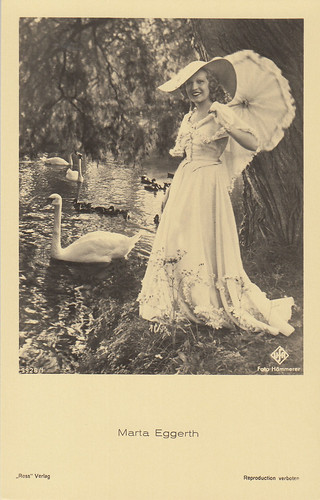
German postcard by Ross Verlag, no. 9928/1, 1935-1936. Photo: Hämmerer / Ufa. Marta Eggerth in Das Hofkonzert/The Court Concert (Detlev Sierck a.k.a. Douglas Sirk, 1936). Collection: Marlene Pilaete.

German postcard by Ross Verlag, no. A 1199/1, 1937-1938. Photo: Paramount. Martha Eggerth and Jan Kiepura in front of their hotel Patria in Krynica-Zdrój, a popular Polish ski resort, near the Czech border. This luxurious modernist hotel, commissioned by Kiepura, was designed by architect Bohdan Pniewski in 1927 and opened in 1933. It had cost Kiepura 3 million dollars, gathered by his successful musicals in Europe and the US. Soon it became the toast of the town, attracting nobility and nouveaux-riches. It was run by Kiepura's parents, while Kiepura and Eggerth lived in Paris. In January 1937 it was the site of a royal scandal when the just-married Dutch crown Princess Juliana and her husband Bernhard, Prince zur Lippe-Biesterfeld, had tried to deceive the press, by sending their luggage elsewhere while hiding at the Hotel Patria. Soon their incognito as Count and Countess Von Sternberg (!) came out and the press sieged the hotel, while Kiepura and Eggerth came back overnight from Paris to welcome the hosts. The weeks in Patria must have been big fun for the royal couple, filled with skiing in the daytime and parties in the nighttime. Martha Eggerth remembered how she had fun with the couple, changing the ski boots in front of the hotel rooms in the middle of the night. During the war, the hotel was used as a sanatorium for German officers. After the war, the hotel was expropriated by the communists and became a state health resort. When Kiepura visited Krynica in 1958 he was not allowed to stay there. After his death, Martha Eggerth tried in vain to reclaim the building.
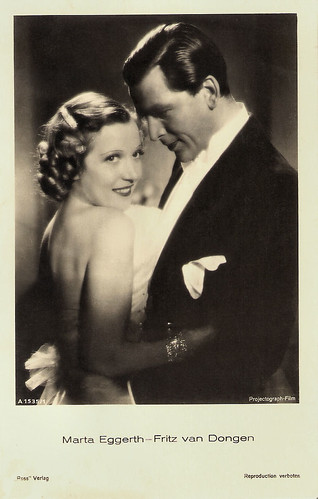
German postcard by Ross Verlag, no. A 1535/1, 1937-1938. Photo: Projectograph-Film. Marta Eggerth and Frits van Dongen in Immer wenn ich glücklich bin..!/Waltz Melodies (Karel Lamac, 1938).
Sources: Ronald Bergan (The Guardian), Anne Midgette (The Washington Post), Thomas Staedeli (Cyranos), Filmportal.de, Wikipedia and IMDb.
This post was last updated on 10 February 2024.

German postcard by Ross Verlag, no. 6799/1, 1931-1932. Photo: Freiherr v. Gudenberg.

German postcard by Ross Verlag, no. 7096/2, 1932-1933. Photo: Atelier Kiesel, Berlin / Aafa Film.

German postcard by Ross Verlag, no. 7311/1, 1932-1933. Photo: Atelier Binder, Berlin.

German postcard by Ross Verlag, no. 7875/1, 1932-1933. Photo: Atelier Binder, Berlin.

German postcard by Ross Verlag, no. 8356/2, 1933-1934. Photo: Atelier Binder, Berlin.
Wunderkind
Márta (or Martha) Eggerth was born in Budapest in 1912. Her mother, a dramatic coloratura soprano, dedicated herself to her daughter, who was called a 'Wunderkind'.
At the age of 11, she made her theatrical debut in the operetta 'Mannequins'. Marta began singing the demanding coloratura repertoire by composers including Rossini, Meyerbeer, Offenbach, and Johann Strauss II.
Soon she was hailed as Hungary's 'national idol'. She performed at the Hungarian State Opera in Budapest. Eggerth made her film debut in Budapest in such silent films as Csak egy kislány van a világon/There Is Only One Girl in the World (Belá Gaál, 1929).
While still a teenager, Márta Eggerth embarked on a tour of Denmark, Holland and Sweden before arriving in Vienna at the invitation of Emmerich Kalman. Kalman had invited her to understudy Adele Kern, the famous coloratura of the Vienna State Opera, in his operetta 'Das Veilchen von Montmartre' (The Violet of Montmartre). Eventually, she took over the title role to great critical acclaim after Kern suddenly became indisposed.
Next, she performed the role of Adele in Max Reinhardt's famous 1929 Hamburg production of 'Die Fledermaus' (The Bat). At the age of 17, she was perhaps the youngest singer ever to undertake this part. Her silvery soprano voice made her a popular star of the operetta in the following years.

Dutch postcard by JosPe, no. 330. Photo: City Film.

Dutch postcard by JosPe, no. 468. With Richard Tauber.

Dutch postcard by JosPe, no. 547.

Dutch postcard by JosPe, no. 593.

Dutch postcard by Filma, no. 664.
German talkie
Márta Eggerth's film career really career took off with the German sound film Bräutigamswitwe (Richard Eichberg, 1931) co-starring Georg Alexander. It was based upon the play, Unwelcome Wife, written by Edward A. Paulton and Fred Thompson. It tells the story of two philanderers who marry each other.
Bräutigamswitwe is the German-language version of the British film Let's Love and Laugh (Richard Eichberg, 1931) which was made simultaneously but with Muriel Angelus. The success of the film resulted in international fame for Eggerth.
Her next film was a crime film, Der Draufgänger/The Daredevil (Richard Eichberg, 1931) also starring Hans Albers and Gerda Maurus. Der Draufgänger was the second film by Richard Eichberg after Der Greifer/The Copper (Richard Eichberg, 1930), in which Hans Albers played an energetic policeman and thus cemented his image as Blond Hans and early action hero of German sound film. The film was shot at original locations in Hamburg harbour.
Then followed the film operetta Trara um Liebe/Trumpet Call of Love (Richard Eichberg, 1931) with Maria Paudler and Georg Alexander, the drama Eine Nacht im Grandhotel/Night at the Grand Hotel (Max Neufeld, 1931) and the comedy Moderne Mitgift/Modern Dowry (E.W. Emo, 1932) with Georg Alexander and Leo Slezak.
Franz Léhar composed the music for Es war einmal ein Walzer/Once There Was a Waltz (Victor Janson, 1932), especially for Eggerth. The story was written by the young Billy Wilder. The film was remade in Britain as Where Is This Lady? (Victor Hanbury, Ladislao Vajda, 1932), again with Márta Eggerth in the leading role.

Dutch postcard, no. 237. Photo: City Film.

Dutch postcard by City Film, no. 464. Marta Eggerth and Hans Junkermann in Traum von Schönbrunn/Dream of Schönbrunn (Johannes Meyer, 1932). Sent by mail in 1934.

Dutch postcard by Filma, no. 450. Photo: publicity still for Die Blume von Hawaï/The Flower of Hawaii (Richard Oswald, 1933), an adaptation of the operetta 'The Flower of Hawaii' by Paul Abraham.

Latvian postcard by IRA, Riga.

Latvian postcard, no. 2284. Photo: J. Rolin (?), Riga. With Hans Söhnker.

Latvian postcard by IRA, Riga, no. 2734. Photo: Ars.
Cheeky, captivating girl
In the silver age of the operetta Márta Eggerth starred in numerous successful film operettas and musical comedies as the cheeky, captivating girl like in Das Blaue vom Himmel/The Blue from the Sky (Victor Janson, 1932), but she also played more tragic roles.
The Austrian-German musical Leise flehen meine Lieder/Gently My Songs Entreat (Willi Forst, 1933) with Hans Jaray is a biopic of the composer Franz Schubert (1797–1828). It was Willi Forst's directorial debut. The German title refers to the first line of the Lied 'Ständchen' (Serenade) from Schubert's collection Schwanengesang, which Eggerth performs in the film.
A British version was also made called Unfinished Symphony (Anthony Asquith, Willi Forst, 1934), again with Jaray and Eggerth. This title refers to the story that Franz Schubert left his symphony unfinished after losing the love of his life. The New York Times wrote: "Hans Jaray's performance reveals Schubert as a gentle and sad-faced youth, inordinately sensitive and at the same time filled with modest confidence in his genius. The well-known German actress and singer, Marta Eggerth, is the lovely aristocrat who laughed at the wrong time, and she helps the photoplay considerably with the warmth and skill of her interpretations of the Schubert songs."
To Eggerth's great successes belong also such film operettas as Der Zarewitsch (Victor Janson, 1933) and Die Czardasfürstin/The Csardas Princess (Georg Jacoby, 1934) and the comedy Die ganze Welt dreht sich um Liebe/The World's in Love (Viktor Tourjansky, 1935).
Critics praised her musical abilities, but also her nuanced acting. In favour of her film work, she appeared less and less on stage.

Dutch postcard.

Dutch postcard.

French postcard by Editions P-C, Paris, no. 113. Photo: Super Film / Vanderheyden. Marta Eggerth sang the English Waltz 'Je veux t'aimer' in C'est un amour qui passe , the French language version of Ein Lied, ein Kuß, ein Mädel/A Song, a Kiss, a Girl (Géza von Bolváry, 1932).Text by Jean Sorbier and music by Robert Stolz. Copyright: Alrobi, Berlin / Editions Salabert, Paris, 1932.

French postcard by Editions P-C, Paris, no. 108. Photo: Ufa. Marta Eggerth sings the Slow Fox 'C'est un amour qui passe' in C'est un amour qui passe (Geza von Bolvary, 1932), an alternate language version of Ein Lied, ein Kuß, ein Mädel/A Song, a Kiss, a Girl (Géza von Bolváry, 1932). Text by Jean Sorbier and music by Robert Stolz. Copyright: Alrobi, Berlin / Editions Salabert, Paris, 1932.

German postcard by Ross Verlag, no. 6748/1, 1931-1932. Photo: Aafa-Film. Marta Eggerth and Rolf von Goth in Es war einmal ein Walzer/Once There Was a Waltz (Victor Janson, 1932).
Dazzling Pair
On the set of Mein Herz ruft nach dir/My Heart Calls You (Carmine Gallone, 1934), Marta Eggerth fell in love with the young Polish tenor and film star Jan Kiepura.
The couple married in 1936, and they were the most dazzling 'Liebespaar' (Love Pair) of the European cinema. They caused a sensation wherever they appeared. In 1936, she also filmed the drama Das Schloss in Flandern/The Castle in Flanders (Géza von Bolváry, 1936) and the operetta Das Hofkonzert/The Court Concert (Detlef Sierck a.k.a. Douglas Sirk, 1936) with Johannes Heesters, both filmed in and around Berlin.
From 1937 on, she was no langer wanted in Nazi Germany because of her marriage to Jan Kiepura. At the time the couple lived in Vienna and worked there in films. Together they starred in Zauber der Boheme/The Charm of La Boheme (Géza von Bolváry, 1937), based on motives from Giacomo Puccini's opera 'La Bohème'. The political situation in Austria became more and more uncomfortable for Eggerth and Kiepura being foreigners.
The leading operetta composers of the day, Franz Lehár, Emmerich Kálmán, Oscar Straus, Robert Stolz and Paul Abraham, all wrote songs for her films. However, by 1938, after the Anschluss, with the exception of Lehár, all of them, being Jewish, had fled Vienna for the US.
Eggerth and Kiepura, who both had Jewish mothers, also left Austria for America, to continue their singing careers there. Márta's last German-language film was Immer wenn ich glücklich bin/Waltz Melodies (Karel Lamac, 1938) with Frits van Dongen, shot in Vienna in 1937.

German postcard by Ross Verlag, no. 5969/1, 1930-1931. Photo: H. Gärner / Eichberg-Film / SF. Marta Eggerth and Georg Alexander in Die Bräutigamswitwe/The widow of the groom (Richard Eichberg, 1931).

German postcard by Ross Verlag, no. 6856/1, 1931-1932. Photo: Atelier Badekow, Berlin / Aafa Film. Kai Heinrich comments at Flickr: "Zum Kennzeichen IA-3628 steht in Dietzlers Auto-Adressbuch für Gross-Berlin 1933: P (Personenwagen) Eggert, Martha, Fräulein, Halensee, Kurfürstendamm 108, Horch 90."

German postcard by Ross Verlag, no. 198/1. Photo: Cine Allianz / Ufa. Jan Kiepura and Mártha Eggerth in the musical comedy Mein Herz ruft nach dir/My Heart Calls You (Carmine Gallone, 1934).

German postcard by Ross Verlag, no. 7677/2, 1932-1933. Photo: Angelo Photos.

German postcard by Ross Verlag, no. 8115/1, 1933-1934. Photo: Atelier Manassé, Wien. Collection: Marlene Pilaete.
MGM Musicals
In 1938, Jan Kiepura and Márta Eggerth fled Austria after its annexation by the Nazis. They first settled down in the South of France, and later in the USA.
Eggerth was signed by the Schubert Theater to appear on Broadway in Richard Rodgers' musical 'Higher and Higher'. She had a leading role and four numbers. It was not a success, but Hollywood had spotted her.
She subsequently signed a contract with Metro-Goldwyn-Mayer, but she only performed in two of the studio's musicals. At the side of Judy Garland, she appeared in For Me and My Gal (Busby Berkeley, 1942), one of the big hits of the year, and Presenting Lily Mars (Norman Taurog, 1943).
Ronald Bergan in his obituary for The Guardian: "Accustomed to being a star, she was offered what she described disdainfully as "a little thing" – a supporting role in For Me and My Girl (1942). Insult was added to injury when her numbers were cut from the film on release. At least Eggerth had a few numbers in Presenting Lily Mars (1943), a vehicle for Garland. However, Garland takes Eggerth off, operatic hand gestures and all, in a comic variation of the aria 'Caro Nome' from Verdi's Rigoletto. It was enough to drive Eggerth from Hollywood forever."
Together with her husband, she returned to the theatre, and they first starred on the operatic stage in 'La Bohème' to rave reviews. Then they had a huge, three-year-long success with Franz Léhar's operetta 'Die lustige Witwe' (The Merry Widow), with Robert Stolz conducting and George Balanchine as choreographer. They would eventually perform 'The Merry Widow' more than 200 times, in five languages throughout Europe and America.

German postcard by Ross Verlag, no. 8356/3, 1933-1934. Photo: Atelier Binder, Berlin.

German postcard by Ross Verlag, no. 8583/1, 1933-1934. Photo: Ufa / Cine-Allianz / Frhr. von Gudenberg.

German postcard by Ross Verlag, no. 8939/2, 1933-1934. Photo: Atelier Binder.

German collectors card in the series 'Vom Werden deutscher Filmkunst - Der Tonfilm', album no. 11, picture no. 137. Photo: Ufa / Ross Verlag. Marta Eggerth in Die Czardasfürstin/The Csardas Princess (Georg Jacoby, 1934).

Italian postcard by Rizzoli & C., Milano, 1936. Photo: Universal.
Flirtatious
After the war, Márta Eggerth and Jan Kiepura returned to France. They toured through Europe and starred in such films as La Valse Brilliante/Brilliant Waltz (Jean Boyer, 1948) in France and Das Land des Lächelns/Land of Smiles (Hans Deppe, Erik Ode, 1952) in Germany. Eggerth wasn't able to gain a foothold again in German cinema, and would further only appear in Frühling in Berlin/Spring in Berlin (Arthur Maria Rabenalt, 1957) starring Sonja Ziemann.
In the 1950s she became an American citizen, but her connection to Europe remained. In 1954 Eggerth and Kiepura brought 'The Merry Widow' to London's Palace Theatre and they often toured through Germany with 'The Merry Widow' and other productions.
After Jan Kiepura died in 1966, Eggerth stopped singing for several years. Finally, persuaded by her mother, she decided to revive her career. In the 1970s she began to make regular television appearances and to actively perform concerts in Europe. In 1979, she was awarded the Filmband in Gold for her longtime achievements in German cinema.
In 1984, she returned to the American stage. She co-starred in the Tom Jones/Harvey Schmidt musical 'Colette' opposite Diana Rigg in Seattle and Denver, and later in Stephen Sondheim's 'Follies' in Pittsburgh. In 1999 Eggerth had a comeback appearance on German television as a chamber singer in the episode Nie wieder Oper/Never Opera Again of the popular crime series Tatort/Crime Scene. In 2005 she brought out a new album, 'Marta Eggerth: My Life My Song', with recordings from throughout her career.
In 2007, the Silent Film Festival of Pordenone in Italy presented one of her first Hungarian films, but the then 95-year-old star was not able to attend. The reason: she had to perform at a concert in New York! Mártha Eggerth always advocated the operetta: "In opera, everybody dies. In operetta, everybody is flirtatious", she said of her favourite art form. Marta Eggerth owned an 18-story apartment building in Rye, New York, where she died 26 December 2013. She was 101.

Vintage postcard, possibly Dutch.

Latvian postcard by Ross, no. 1111. Photo: E & B, R(iga). Mailed in Latvia in 1936.

Italian postcard by Rizzoli, Milano, 1937.

German postcard by Das Programm von Heute / Ross Verlag. Photo: Atelier Schenker, Berlin.

German card. Photo: Mitteldeutsche Union Tonfilm. Martha Eggerth and Hans Söhnker in Wo die Lerche singt/Where the Lark Sings (Karel Lamac, 1936).

German postcard by Ross Verlag, no. 9928/1, 1935-1936. Photo: Hämmerer / Ufa. Marta Eggerth in Das Hofkonzert/The Court Concert (Detlev Sierck a.k.a. Douglas Sirk, 1936). Collection: Marlene Pilaete.

German postcard by Ross Verlag, no. A 1199/1, 1937-1938. Photo: Paramount. Martha Eggerth and Jan Kiepura in front of their hotel Patria in Krynica-Zdrój, a popular Polish ski resort, near the Czech border. This luxurious modernist hotel, commissioned by Kiepura, was designed by architect Bohdan Pniewski in 1927 and opened in 1933. It had cost Kiepura 3 million dollars, gathered by his successful musicals in Europe and the US. Soon it became the toast of the town, attracting nobility and nouveaux-riches. It was run by Kiepura's parents, while Kiepura and Eggerth lived in Paris. In January 1937 it was the site of a royal scandal when the just-married Dutch crown Princess Juliana and her husband Bernhard, Prince zur Lippe-Biesterfeld, had tried to deceive the press, by sending their luggage elsewhere while hiding at the Hotel Patria. Soon their incognito as Count and Countess Von Sternberg (!) came out and the press sieged the hotel, while Kiepura and Eggerth came back overnight from Paris to welcome the hosts. The weeks in Patria must have been big fun for the royal couple, filled with skiing in the daytime and parties in the nighttime. Martha Eggerth remembered how she had fun with the couple, changing the ski boots in front of the hotel rooms in the middle of the night. During the war, the hotel was used as a sanatorium for German officers. After the war, the hotel was expropriated by the communists and became a state health resort. When Kiepura visited Krynica in 1958 he was not allowed to stay there. After his death, Martha Eggerth tried in vain to reclaim the building.

German postcard by Ross Verlag, no. A 1535/1, 1937-1938. Photo: Projectograph-Film. Marta Eggerth and Frits van Dongen in Immer wenn ich glücklich bin..!/Waltz Melodies (Karel Lamac, 1938).
Sources: Ronald Bergan (The Guardian), Anne Midgette (The Washington Post), Thomas Staedeli (Cyranos), Filmportal.de, Wikipedia and IMDb.
This post was last updated on 10 February 2024.
No comments:
Post a Comment